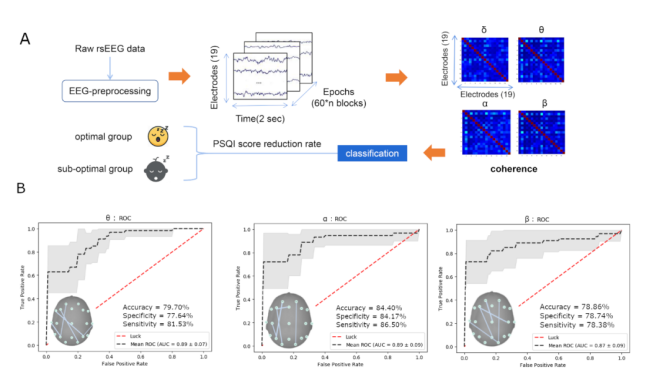By collecting and analyzing resting-state EEG signals of insomnia patients for a few minutes, it is possible to predict the effectiveness of rTMS treatment in patients. Kai Yuan's research group from Xidian University, Yifei Zhu's team from the Department of Psychosomatic Medicine of the Second Hospital of Hebei Medical University, and Dahua Yu's research group from Inner Mongolia University of Science and Technology have jointly carried out rTMS intervention in primary insomnia EEG research, and recently made a series of research progress.
Insomnia disorder is a risk factor for neurological disease and cognitive deficits, and is accompanied by abnormal brain connections. EEG coherence, an important measure of functional connectivity, measures the synchronization of oscillations between brain regions and may partly reflect hyperarousal states in insomniacs. rTMS has been found to treat insomnia patients by regulating neuron activity and neuroplasticity. However, the clinical effect is very heterogeneous. Therefore, it is of great clinical significance to construct a prediction model for the efficacy of rTMS based on coherence.

In Study 1, patients with insomnia were randomly divided into a true treatment group and a sham treatment group, and received 20 times of 1Hz rTMS treatment with the left dorsolateral prefrontal cortex as the target using the TMS device produced by Shenzhen Yingchi Technology Co., Ltd. Before and after rTMS, the EEG and clinical evaluation of the awake state were collected and analyzed, and the EEG mechanism of rTMS intervention insomnia was explored. In Study 2, 120 insomnia patients who received the same true treatment were divided into the best treatment effect group and the poorest treatment effect group according to the median reduction rate of the Pittsburgh sleep quality index after treatment, and based on the EEG coherence in different frequency bands in the baseline state, a machine learning model was established to predict the effect of rTMS treatment. The results showed that after rTMS treatment, the sleep of patients with insomnia was improved from both subjective and objective levels, the EEG coherence between some leads of θ and α frequency bands decreased, and the change of θ frequency band (F7-O1) coherence was related to the change of sleep efficiency. Furthermore, EEG coherence in θ, α, and β bands at baseline showed the potential to predict the efficacy of rTMS in patients with insomnia, with EEG coherence in the α band performing best in classification prediction.
In brain diseases, EEG measurements, especially resting-state functional connectivity, have been shown to be a reliable diagnostic tool and classifier. This study also supports the role of EEG as a prognostic tool in patients with rTMS for insomnia, explores the mechanisms associated with EEG coherence, and identifies potential predictors of rTMS for insomnia. The paper was published in the Journal of Psychiatric Research (DOI: 10.1016/j.jpsychires.2023.02.005) in 2023, and the first author is Xiaozi Zhang, a master student at the School of Life Sciences, Xidian University.
The link of literature:
https://www.sciencedirect.com/science/article/abs/pii/S0022395623000626
The "hypervigilance" model suggests that insomniacs are in a neurobiological and psychological state of hypervigilance, which manifests itself in cortical hyperarousal during wakefulness and sleep. Hyperexcitability of the cortex alters the firing patterns of neurons, manifesting as abnormal neural oscillations. Most previous EEG studies used spectral features to characterize abnormal neural oscillations in insomnia patients, namely higher β and γ power and lower δ, θ and α power. Cross-frequency coupling characterizes the relationship between the amplitude/phase of EEG signals in different frequency bands. Among them, phase-amplitude coupling (PAC) is one of the most studied cross-frequency coupling, which is considered as a potential mechanism of advanced functions such as cognition, memory and information integration, it may be a reliable quantitative index to describe abnormal neural oscillations in insomnia patients and reveal the mechanism of rTMS in the treatment of insomnia disorders.

In order to verify the above hypothesis, this paper recruited insomnia patients (randomly divided into true treatment group and sham treatment group), and used the TMS equipment produced by Shenzhen Yingchi Technology Co., Ltd. to carry out rTMS treatment (1Hz left DLPFC) for four weeks. Behavioral assessments, resting state electroencephalography, and polysomnography were performed before and after rTMS treatment. The results of the study showed that the theta-gamma phase-amplitude coupling values of the frontal and temporal lobes in the insomnia patients group were weaker than those of the healthy controls at baseline, while the phase-amplitude coupling values near the frontal lobe were significantly enhanced after rTMS treatment. In addition, enhancement of phase-amplitude coupling values was significantly associated with improved sleep quality.
This study reveals the potential of phase-amplitude coupling in assessing insomnia severity and rTMS treatment efficacy, providing new insights into the abnormal physiological mechanisms of insomnia and future therapeutic targets. This paper was published in the Human Brain Mapping (DOI: 10.1002/HBM.26264) in 2023, and the first author is Yongjian Guo, a master student at the School of Life Science, Xidian University.
The link of literature:
https://onlinelibrary.wiley.com/doi/10.1002/hbm.26264
——END——
Statement
This content is authorized by Professor Yuan Kai from Xidian University.
